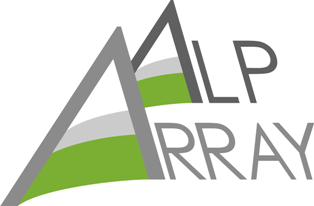AlpArray

|
AlpArray is a European initiative to advance our understanding of orogenesis and its relationship to mantle dynamics, plate reorganizations, surface processes and seismic hazard in the Alps-Apennines-Carpathians-Dinarides orogenic system. The initiative integrates present-day Earth observables with high-resolution geophysical imaging of 3D structure and physical properties of the lithosphere and of the upper mantle, with focus on a high-end seismological array. AlpArray is a major scientific collaboration with over 40 participant institutions. One of the main actions of the AlpArray initiative is to collect top-quality seismological data from a dense network of temporary broadband seismic stations. This complements the existing permanent broadband stations to ensure homogeneous coverage of the Alpine area, with station spacing on the order of 30km. 24 institutions are currently involved in the AlpArray Seismic Network (AASN), which will eventually install over 250 temporary stations in 12 countries. The AASN officially started on 1 January 2016 and will operate for at least 2 years. A complimentary ocean bottom seismometer (OBS) component is expected in 2017. The Swiss contribution to the AASN is completed, with 23 temporary stations installed in Switzerland, Italy, Bosnia and Herzogovina, Croatia and Hungary. All national broadband stations also contribute to the AASN. The Seismology and Geodynamics group (SEG) and the Swiss Seismological Service (SED) at the ETH in Zurich take leading roles in the project. Prof Edi Kissling is the project coordinator. Irene Molinari (SEG), John Clinton (SED) and Gyorgy Hetenyi (former SED, now at the University of Lausanne) lead AlpArray working groups, Irene Molinari also manages the Swiss component of the AASN. More information is available on the project website. |
|---|---|
| Project Leader at SED | Prof. Edi Kissling (SEG) |
| SED Project Members | Irene Molinari (SEG), John Clinton, Stefan Wiemer, ELAB |
| Funding Source | SNF |
| Duration | 2015 - 2018 |
| Keywords | Alps, earthquakes, seismic broadband network, tomography, geodynamics, surface process, orogenesis |
| Research Field | Seismotectonics, Real-time monitoring, Earthquake Hazard & Risk |
| Website | http://www.alparray.ethz.ch/home/ |